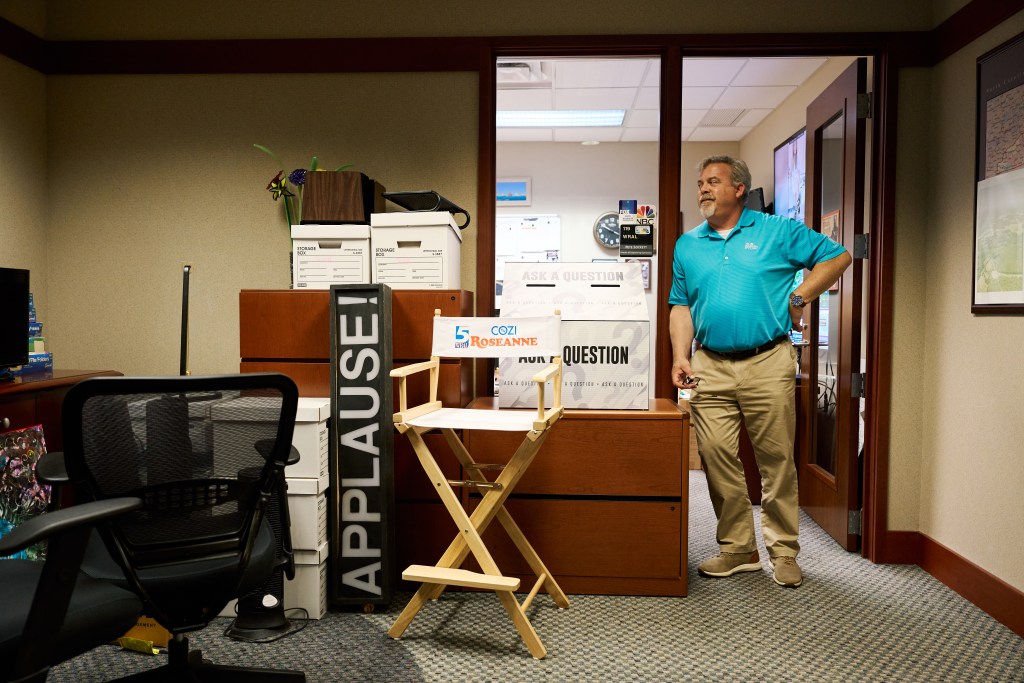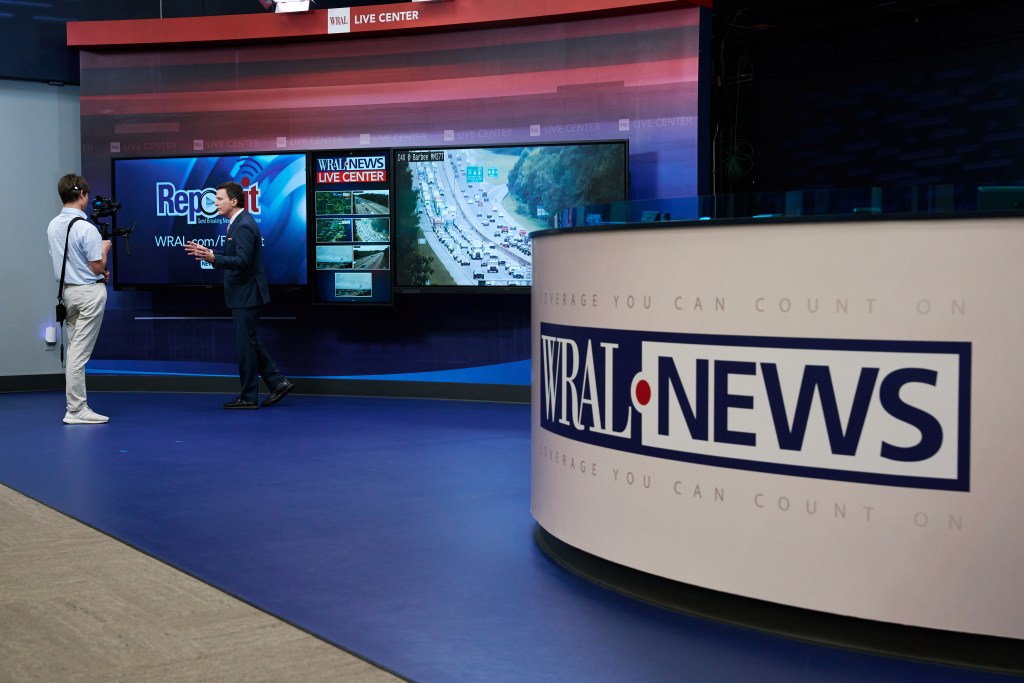Posted above the double-door entryway to WRAL-TV’s Raleigh headquarters is a quote from founder A.J. Fletcher: “To inform the public without bias or favor is this station’s highest duty.”
Behind those doors is a warren of conference rooms, studios, control rooms, and a large, open-plan newsroom. James Goodmon Jr., the fourth-generation president of WRAL and its family-owned parent company, Capitol Broadcasting, strides down hallways filled with plaques and memorabilia commemorating the station’s impact on local journalism.
Inside the main control room, he looks on as a group of producers seated before an array of 15 monitors speak calmly but rapidly into their headsets, executing the complicated, minute-by-minute choreography that is the 4 p.m news. Next door in the studio, he watches as a pair of anchors prepare to go live, a “Breaking News” banner scrolling across the screen in front of their desk.
A few minutes later and one floor down, Goodmon Jr. sits at a long conference table and absentmindedly rakes his hands across his face, pushing his rectangular glasses onto his forehead.
“I’m really proud of what you saw up there, and I don’t really care if other people think that or not,” he says, letting out an exhale somewhere between a wry laugh and an expression of defiance.
He speaks about the family business in epic terms: “This is a war,” he told INDY and The Assembly in a recent interview. “This is a big battle that we’re fighting every day.”
Goodmon Jr. is battling for advertising dollars against bigger, richer competitors. He’s fighting to hold his audience’s attention amid stiff competition from social media, streaming services, and AI-generated Google search results. And he’s in a race against time, trying to predict the next trends and technological advancements in media to keep his station profitable and relevant.
Much has been written about the death of print news in the digital age, but the business model for local TV news is breaking, too. Viewership has steadily decreased since 2016, according to data from the Pew Research Center, and advertising revenue has trended down as well, notwithstanding bumps from political ads during election years.
Profit margins are slimmer than they were 30 years ago, to the point where the vast majority of local stations have been bought up by a handful of corporations. Of the local ABC, NBC, and CBS affiliates in the nation’s top 25 biggest media markets (Raleigh is No. 22), NBC affiliate WRAL is the only one that isn’t owned by a corporate parent like Sinclair, Tegna, Nexstar, or Disney.
The last five years have thrown additional hurdles in WRAL’s path, including a transition to a new chief executive and a string of high-profile departures from the newsroom and anchor desk.
There have been casualties in Goodmon Jr.’s “big battle”—longtime employees who say they were laid off or offered steeply reduced contracts, and others who left the station abruptly and without explanation. They say WRAL is losing some of the family culture that distinguished it from corporate-owned competitors and helped keep viewers loyal.
Asked about the departures, Goodmon Jr. said some staffers had been resistant to change.
“This isn’t a kindergarten,” he said. “In order to succeed, you gotta adapt, you gotta change. And you can either embrace that and become curious … which is what we want to do, or you can resist it. We’ve probably been overly considerate as it relates to overlooking those that have been resistant over time.”
In spite of the headwinds, WRAL is still relatively well-positioned. It has a newsroom staff of 143 and a host of profitable companies under the Capitol Broadcasting umbrella to cushion the TV station against financial stumbles. The station does consequential political and investigative reporting, and it regularly wins coveted regional Emmy and Murrow awards. Its role as a public good has never been clearer as other local news sources shrink and disappear.
WRAL makes its own decisions and, to some extent, controls its destiny. Sinclair and Nexstar recently told their more than 60 ABC affiliate stations (including WXLV in Winston-Salem and WCTI in New Bern) not to air “Jimmy Kimmel Live!” after the host’s comments about Charlie Kirk’s death; Goodmon Jr. has no faraway corporate boss to answer to. (Sinclair and Nexstar said Friday that they were bringing Kimmel back.)
“WRAL is—both in terms of its record through the years doing news and its economics—atypical of the whole universe of local stations,” said Rick Edmonds, a media business analyst for the Poynter Institute, a nonprofit journalism organization. “Very few are that dominant in a market, and very few have as big a commitment, at least historically, to doing some pretty ambitious news.”
The business model may be changing underfoot, but Goodmon Jr., 48, who’s better known around the station as Jimmy, is sanguine about WRAL’s prospects.

“I really want Capitol Broadcasting to be doing local news in Raleigh 100 years from now,” he said. “I don’t know what that means. I don’t know what device it’ll be on. I don’t know if it’ll be here or Mars. But … at the end of the day when the dust settles, if we’re not here, they’ll find me with my knuckles broken.”
Prescient Bets
Fletcher, who founded Capitol Broadcasting Company (CBC), was Goodmon Jr.’s great-grandfather. He began amassing local media properties in the 1930s with the purchase of an AM radio station. In 1956, he branched into television, securing the license to Channel 5 and founding WRAL-TV.
By the time of Fletcher’s death in 1979, CBC also owned the Tobacco Radio Network, the North Carolina News Network, Capitol Publications, Capitol Broadcasting Network, and Seeburg Music Library, Inc. Fletcher also had an eponymous charitable foundation and a slate of broadcasting awards to his name.
He was succeeded as CBC president in 1966 by his eldest son, Fred, who in addition to serving as president of CBC until his retirement was a community fixture in Raleigh: He was elected to the city council and chaired various Wake County parks boards for decades.
James Fletcher Goodmon Sr., Fred’s nephew, took over as president of Capitol Broadcasting in 1975. Goodmon Sr. made prescient bets on emerging technologies: WRAL was the first TV station in North Carolina to get a news helicopter (1979) and a satellite truck (1984); the first in the Triangle to launch a website (1996); and the first in the world to air an all-high definition newscast (the 5 p.m. news on October 13, 2000).
“They were possibly the leading station in the entire country, certainly one of a handful, that was very aggressive in moving to digital outputs,” said Lee Meredith, an adjunct instructor at the University of North Carolina at Chapel Hill’s Hussman School of Journalism and Media, and former general manager of several television stations around the Southeast.
WRAL’s early move to digital involved a substantial investment that Goodmon’s corporate counterparts—motivated by their bottom lines—were reluctant to make.
“Back then, every local TV station … just made money hand over fist and tried not to give any to their employees if they didn’t have to,” recalled Ed Crump, who joined WTVD/ABC11 as a reporter in 1984 and stayed for 37 years.
The calculus was different for WRAL, Meredith said.
“One of the biggest pros of local ownership is a focus on serving this local community,” he said. “They can decide how much profit they’re going to make and how much service they’re going to provide. In a big company, that’s not going to be a local decision.”
The investments paid off: Under Goodmon Sr., the station was widely lauded as the best in the region, beating out its neighbors WTVD/ABC11 (owned by Disney) and WNCN/CBS17 (owned by Nexstar).
“We may have been breaking the same story, but more people were watching [WRAL], and that was a fact,” said Dwayne Ballen, a sports anchor for Channel 11 in the 1980s and ’90s.

Also during Goodmon Sr.’s tenure as CBC president, the company bought the Durham Bulls minor league baseball team, sprouted a real estate division, and redeveloped Durham’s abandoned American Tobacco factory campus into a multiuse district. Jimmy’s brother, Michael, runs the company’s real estate and sports divisions.
The elder Goodmon wanted Jimmy to learn every part of the broadcasting business he would one day lead. So in the 1990s, Jimmy started working as a camera operator for WRAL’s 5 a.m. newscast. He was 16 years old.
From there, Goodmon Jr. bounced between different areas of CBC’s increasingly vast network of businesses, managing a handful of radio stations, acquiring new properties for the company, and leading CBC’s New Media Group. In 2017, he became president and COO of CBC. This May, he officially took over the CEO title from his father, who continues to serve as chairman of CBC’s board of directors.
“Dad, to me, is the GOAT,” Goodmon Jr. said, using the acronym for Greatest Of All Time. “Everything I learned about what we’re up to comes from him. … He sort of lives rent-free in my mind and heart all the time.”
But Goodmon Jr. is operating in a different media landscape than his father. The generation of TV watchers who tuned in like clockwork for WRAL’s evening news is aging. Younger people are much more likely to get their news from websites, apps, and social media than television, according to Pew data.
“Our audiences are changing so fast,” Goodmon Jr. said. “It’s definitely become a more complex business in order to serve those needs.”
In 1995, WRAL broadcast four hours of local news each weekday. Today, that number has ballooned to 11 hours across WRAL and WRAZ, the local Fox affiliate that Capitol Broadcasting also owns. Then there’s WRAL News Plus, a 24/7 streaming channel that provides continual news and weather updates. Not to mention the mobile app, website, and multiple radio stations pumping out their own feeds of local news.
More local news sounds great on its face, but there are a couple of potential problems with this strategy. For one, WRAL is still an advertising-based company, and digital advertising is far less profitable than TV advertising—Meredith called it “trading analog dollars for digital dimes.”
Plus, WRAL doesn’t seem to have expanded its reporting staff in proportion to its new multiplatform endeavors. The station would not tell the INDY and The Assembly how staffing levels have changed in the last decade, but former employees say they watched their departments shrink even as they were asked to produce more.
Goodmon Jr. pushed back against the idea that recent departures at WRAL are anything more than the usual churn all companies experience: “We’ve had a lot of people who have left in my tenure. How I would compare that to now is, it’s the exact same as it’s always been,” he said.
Former staff tell a different story. The INDY and Assembly spoke to several longtime employees who said they were laid off or offered steeply reduced contracts. Others said they saw the writing on the wall and left of their own accord for new opportunities. They said the station feels less like a family and more like a business than ever before—nothing irregular in the competitive world of local broadcasting, but a departure from the WRAL of decades past.
High-profile Departures
Earlier this month Laura Leslie, WRAL’s capitol bureau chief, announced she was leaving the station to become the new editor at NC Newsline, a Raleigh-based nonprofit news site. Leslie spent nearly 15 years at WRAL and became one of North Carolina’s most authoritative voices on state politics.
She declined to comment to the INDY and The Assembly about why she decided to make the move, but wrote in an announcement that “at a time when so many traditional media outlets are shrinking, [NC Newsline’s parent] States Newsroom is expanding its coverage of policy debates that affect readers’ everyday lives.” She added that she’s “grateful to WRAL for the opportunity the station gave me and the many skills I learned during my time there.”
Following Leslie’s announcement, WRAL news director Mike Friedrich told the News & Observer she “has been an important contributor for several years, but we are proud of our NC Capitol Team already in place.” Some WRAL veterans considered that disrespectful to Leslie.

Leslie is not the only recent high-profile departure. In March, visual design director Shan Zhong, a 37-time regional Emmy award winner, left after almost 19 years. He did not respond to a request for comment.
Enterprise executive producer Ashley Talley also left in March; she, too, declined a request for comment. Talley oversaw Murrow- and Emmy-award winning work during her nearly six years at WRAL and now works for Tegna.
Anchors Julian Grace and Aaron Thomas both departed the station abruptly this summer after each worked there for six years. Thomas did not respond to a request for comment, but has taken an anchor/reporter job at WLWT in Cincinnati. Grace told the INDY and The Assembly that when his contract with WRAL ended in June, he decided to take a break from journalism to promote his new book.
News anchor Debra Morgan, a 32-year newsroom veteran, also left WRAL this summer and did not respond to the INDY and The Assembly’s inquiries about why and what’s next for her.
Beloved lead anchor David Crabtree, 19-year news director Rick Gall, politics reporter Travis Fain, reporting veteran Amanda Lamb, and general manager Joel Davis all moved on for new opportunities or retired within the last two years. Although they left by choice (Crabtree was 72 years old when he left to become CEO at PBS North Carolina), their colleagues said the loss of institutional memory is a blow for the station, whose staff is leaning younger and less experienced.
Gilbert Baez reported from Fayetteville for 17 years until late 2024, when he was told his contract wasn’t being renewed.
“They had every right to do that. I had 17 great years with them,” Baez said. “I’m sure WRAL and WTVD and WNCN, everyone is making adjustments right now. That may seem shocking, but it really shouldn’t be.”
Arri Woodhouse, an associate producer who started at WRAL in 2023, resigned in April 2024 to take a broadcasting job in Charlotte at Queen City News (WJZY). “In all the newsrooms that I’ve ever worked in,” she said, “you will see somebody one day, and then you’ll come in the next day, and there’s an email saying, ‘This person is no longer with the company.’”
Still, Woodhouse found the departures at WRAL jarring.
“They got rid of all of our administration at the front desk,” she said. “And a few other people that I wasn’t exactly close with, but it was definitely felt when they left, because their responsibilities fall on other people. … It definitely led to people being overworked.”
Six former employees requested anonymity to speak candidly with the INDY and The Assembly. Almost universally, they acknowledged that WRAL is up against the same headwinds as the entire TV news industry and that turnover is normal, but they expressed discomfort that longtime employees were leaving against their will or, in some cases, without giving any explanation to the staff.
Asked about the departures, Goodmon Jr. was adamant that “we haven’t made any mistakes” and that the few times WRAL has terminated a contract, it was for cause. He also said that the news team has grown compared to 10 years ago.
“We compete with Disney right next door, and Sinclair, and then there’s little old redneck Capitol Broadcasting Company,” he told the INDY and The Assembly. “And what do you think [the others] are doing? They’re cutting without reinvestment.”
Jeff Gravley spent most of his three-decade journalism career at WRAL. He started in 1985 as an intern and worked his way through the ranks to become a sports photographer, then a reporter, and finally a sports anchor.
For a long time, it was a dream job. He covered ACC tournaments, Final Fours, two Super Bowls—the station even sent him to Rio de Janeiro for the 2016 Olympics. His coworkers, many of whom he’d worked with for decades, felt like family. Together, they were producing some of the most-watched, highest-quality local news and sports coverage in the Triangle. Gravley was named WRAL’s lead sports anchor in 2008 and racked up seven regional Emmy awards.
In summer 2019, he was called into a meeting with the station’s general manager and news director. They told Gravley they were terminating his contract early and offering him a new one at half his previous salary. There were no issues with his performance, Gravley remembers them telling him during the meeting. This was purely a financial decision.
Gravley ended up turning down the new contract and leaving WRAL—and journalism—later that year. He now works for the NC State athletics department.
He believes he got out at the right time: His early years on the job coincided with WRAL’s financial and ratings heyday, but by the time he left, things weren’t so rosy. The sports staff was traveling less, getting less air time, and had shrunk considerably.
“It was a gut punch,” Gravley recalled. “It happens in business. But when it happens to you at a place with a reputation like WRAL, it kind of hits different. I felt like I had done all the right things, worked through the ranks, paid my dues … and then all of a sudden, boom, the rug is pulled out.”
Next Generation
When the INDY visited WRAL recently for a newsroom tour, rain was slanting down in sheets outside. Severe weather means a busy day of breaking news (WRAL has seven meteorologists) and live updates for the news team, and the building was humming with activity.
Goodmon Jr., dressed unfussily in khakis and a navy Durham Bulls-branded polo shirt, traded greetings with camera operators and producers as he loped down long corridors past banks of monitors.
He stopped to point out a shiny new piece of tech: an automatic teleprompter that learns individual anchors’ speech patterns and customizes the pace of its scroll. Back in the day, Goodmon Jr. used to operate a manual version of the teleprompter during live newscasts.
“That position that I was in isn’t here anymore. We don’t have a teleprompter operator anymore,” he said. “But think about all the things that we’re doing now that we weren’t doing.”

In one studio space, a reporter in a suit and a teenage camera operator in a headset were filming a traffic report. After they finished, Goodmon Jr. ambled up to the operator and started ribbing him. “It looked a little bit shaky in the last shot,” he teased.
The young camera operator was none other than Goodmon Jr.’s eldest son, Fletcher, who is 16. The presumptive heir to the Capitol Broadcasting empire blushed as his dad leaned in for an awkward forehead kiss.
“There’s nobody who wants things not to change more than me,” Goodmon Jr. said later that day. “However, I also realized very early in my life, that’s like talking about unicorns. Everything is going to change.”
Jane Porter contributed reporting.
Chloe Courtney Bohl is a Report for America corps member. Follow her on Bluesky or reach her at [email protected]. Comment on this story at [email protected].
